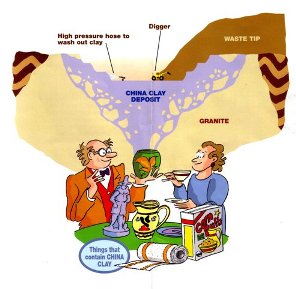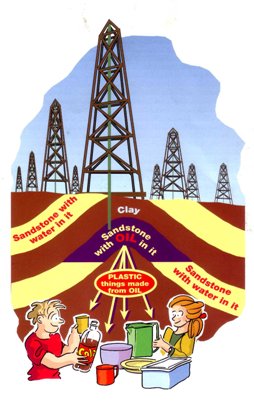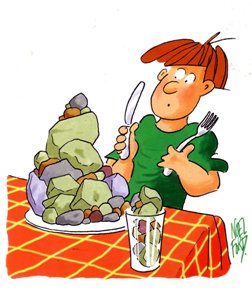The ground under our feet is made of many different kinds of rock. In some places we can see the rocks, but often they are buried under soil, roads or buildings. If we dig into the ground we will always find rock, as we do in quarries and mines.
Rocks are made of minerals, which are solid chemical elements or compounds that occur naturally. Rocks may be hard, such as granite, limestone and coal, or soft, such as sand and clay, but they are always made up of minerals.
- Are there any rocks to be seen near your school or home? If so, have you looked at them closely?
Collect some rock samples with your teacher or parent and look at them carefully through a magnifier. Can you see that they are made up of minerals grains? Do there seem to be different sorts of minerals?
It may seem strange, but we need rocks for all our meals. They are used to make the crockery and cutlery we use at meal tables. More surprisingly, they – or the minerals they contain – are present in many of the things we eat and drink.
Setting the table

During meals, we use lots of bowls, plates, cups and saucers. This crockery is all made from clay. We use special clays called china clay and ball clay to make crockery.
The clays are formed when one of the minerals in another type of rock, granite, crumbles and rots. So, we find the clays in areas where there are granites, such as Devon and Cornwall.
Crockery is made by forming these clays into the shapes we want and heating them in a kiln until they are baked hard.
- When clay is baked, what sort of changes take place? Where else in your home or school do you think clays are used as pottery? Can you find clay near to your home or school? Look at some clay through a magnifier – can you see what it is made of? If not, why not?
- Look at a piece of granite through a magnifier. Can you see that it is made up of crystals of different minerals? Only one of these – the white or pinkish one – breaks down to form the minerals in china clay and ball clay (in case you are curious to know, it is called feldspar). The clear crystals are quartz; the flat shiny silver or black specks are mica.
Back to top
Things for cooking and eating
We need pans for cooking and kettles to heat water and these are usually made from steel or aluminium. So are the knives, forks and spoons we use. We may also wrap food in aluminium foil to protect it or to bake it in the oven.
'Ores' are the minerals or rocks that provide the metals we need, like steel and aluminium. Steel is made by melting a mixture or iron ore, limestone and coke (made from coal) in a large furnace. To improve steel – for example, to make it stainless – we add other metals such as nickel or chromium. All the materials we need to make steel come from rocks.
The metals are obtained from ores found in many different countries. There are limestones in many parts of Britain – most were formed from the remains of shelly creatures that lived in ancient seas that no longer exist. Coal found in Britain was formed from plants that grew in swamps about 300 million years ago – these plants became buried under sand and mud and gradually changed into coal.
- Is there any limestone near your home or school? If so, go with your teacher or parent and look at it carefully. Describe what you see. A magnifier could help – the rock may contain small fossils.
- Look closely at a piece of coal (or, much better, at the waste rock found with coal on old tips). Does it contain evidence that coal was formed from plants? It may contain marks of the leaves and bark of ancient plants from which it was formed.
- Use reference materials to find out which countries produce iron ore and bauxite. Find our where steel, aluminium and crockery are made in Britain.
Back to top
Glassware
We often drink out of a glass. Glass is made from a special sand made up of pure quartz grains mixed with limestone and other chemicals which are added to give the glass its colour, strength and brightness. For example, lead oxide makes glass heavier and gives it a sparkle; cobalt gives glass a lovely blue colour.
Sand is very common - we can find it on the beach, in sand dunes and in sandpits. To make glass, very pure quartz sand is needed; ordinary sand is not pure enough to make clear strong glass because it has impurities such as iron, which makes the glass dark brown or green.
-
Get some sand from a beach or a builders’ merchant and look at it through a magnifier. Most of the grains are likely to be made of quartz and will appear clear (glassy) or white. Some grains may be stained red or brown by a thin layer of iron oxide (rust). In beach sands there may also be salt, shell fragments or small pieces of other rocks. It is these other materials which make the sand unsuitable for making glass.
Back to top
Plastic items

Items used at a meal table are sometimes made of plastic rather than glass, metal or pottery. Does this mean that we don’t need rocks at meal times after all? No, it doesn’t because plastics are made from oil (together with other chemicals and ‘fillers’ such as china clay and limestone), and oil comes from rocks.
When grains of sand and mud from rivers are carried out to sea they settle on the sea floor to form layers of sediment. The remains of any plants (especially algae) and animals that live in the sea become trapped between the sediment grains.
When the sediments of ancient seas become buried and form rocks, the plant and animal remains break down into a brown, sticky liquid called crude oil. The oil can become trapped in the rocks, and we can take it out of the ground by sinking boreholes to find it.
In Britain, we get much of our oil from boreholes sunk into the floor of the North Sea. The oil is found in rocks a kilometre or more under the sea floor. It is used to make petrol and many other everyday items, including plastics.
- Make a list of all the plastic items you use at the meal table during a single day.
- Why are plastics used so widely in place of other materials?
Back to top
Eating rocks can be good for you, but only the right ones!

Do we really eat rocks as well, or the minerals we find in rocks?
Yes we do, because many breakfast cereals contain up to six elements (iron, zinc, calcium, potassium, phosphorus and magnesium) which are needed to keep our bodies healthy. All these elements come from minerals in rocks so, with every mouthful of cereal, we are eating rocks as part of our daily diet.
- Look at your cereal packet to see what elements it contains (they may be listed as ‘minerals’). Where do you think these may have come from? Try to find out how the elements found in cereals help to keep us healthy. Possible clues: bone formation, muscle movement.
We add salt to many foods during cooking, or sprinkle salt on our meal at the table. Salt is also used to preserve food. All the world’s salt is dissolved from rocks, and it collects in salty waters of the seas and oceans.
We can obtain salt by evaporating sea water, as is done in many countries, or by taking rock salt out of the ground, as we do in Britain. Rock salt forms when seas dry up to leave large deposits of salt. This happened in seas that covered parts of Britain 200-250 million years ago, when the country was near to the equator, and the salt became buried under later sediments. We take salt out of the ground by drilling boreholes to pump water down into the layers of rock salt to dissolve it and pump the brine back to the surface.
- If you live near the sea, collect some sea water (with your teacher or parent) and evaporate it in a dish in the classroom: what is left in the dish? Salt is found in sea water and in some rocks, as rock salt: Is there a link between these two facts? Do you know where rock salt is found in Britain? Can you think of any other uses for salt?
You might think that bread is made just from flour, but it also contains a small amount of salt, limestone (to make it white) and gypsum. Gypsum is also used in small amounts in the making of many types of ice cream, cheese and some other foods. Gypsum is found along with salt in rocks that formed in the seas that covered parts of Britain 200-250 million years ago.
Back to top
Do we drink rocks too?
About a third of all our drinking water is taken from rocks under the ground using boreholes and springs. This water contains lots of elements that have been dissolved out of the rock. These elements include calcium (rich in waters from limestone areas, and the cause of hard water), sodium, potassium and magnesium. They are important for our health, and give the water its special taste.
- Look at the label on a range of bottled mineral waters to see what elements they contain. Look for differences between the different bottles- what might be the cause of these differences? Do you think these elements affect the taste of the water (try tasting distilled water!). Do you think the elements are important to our health?
Back to top
We don't eat paper, but we use it during meals - and it contains rocks too!
We use paper, or cardboard, for the packaging of foods such as cereals. We often use paper tissues to mop up the mess when baby knocks a glass of fruit juice over dad’s tie! Most types of paper contain not only wood pulp but also some clay. The clay provides weight and ‘glossiness’ to the paper - the more clay, the more glossy the paper. Cereal packets have high clay content to provide weight and a good surface to print on.
- Get a glossy magazine and fold a newspaper so that it is the same size and thickness as the magazine. Is there any difference in weight between the two items? If so, what do you think is the reason for this difference, and what effect has it had on the quality of the paper?
Back to top
Protecting our world
Most of the time, we just take things for granted and don’t stop to wonder about the origin of the items we use every day in our homes. As we have seen, many of these come from rocks. The world’s rocks are therefore very important to use so we have to be very careful with their use and save some for future generations. Wherever we can use rock products more than once, we should recycle them.
- Make a list of the things we use at the meal table that could be recycled. Find a label, for example on a food packet, that claims to use recycled material.
- Do you have any working quarries near your school? If so, what kind of rock is being quarried and what is it being used for? – are there any products from the quarry that are used at meal time, or in other ways in your home or school?
Back to top
Written by B Taylor, H Heason and M Brooks. October 1998
Source material
'The importance of industrial minerals in everyday life'.
Hal McVey. Geology Today, Jan-Feb 1997
(Deals with Early morning, Going to work, At the Office, and Towards the end of the day)